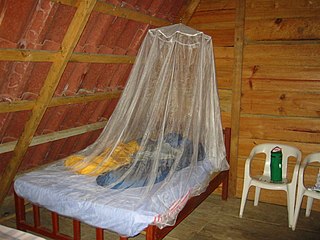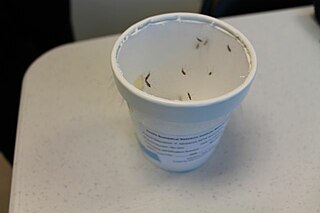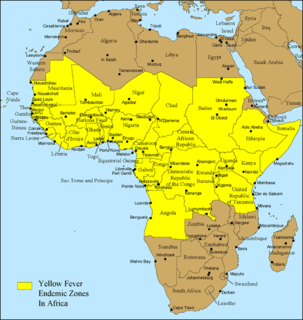
Dichlorodiphenyltrichloroethane, commonly known as DDT, is a colorless, tasteless, and almost odorless crystalline chemical compound, an organochlorine, originally developed as an insecticide, and ultimately becoming infamous for its environmental impacts. It was first synthesized in 1874 by the Austrian chemist Othmar Zeidler. DDT's insecticidal action was discovered by the Swiss chemist Paul Hermann Müller in 1939. DDT was used in the second half of World War II to control malaria and typhus among civilians and troops. Müller was awarded the Nobel Prize in Physiology or Medicine "for his discovery of the high efficiency of DDT as a contact poison against several arthropods" in 1948.

Quinine is a medication used to treat malaria and babesiosis. This includes the treatment of malaria due to Plasmodium falciparum that is resistant to chloroquine when artesunate is not available. While used for restless legs syndrome, it is not recommended for this purpose due to the risk of side effects. It can be taken by mouth or used intravenously. Malaria resistance to quinine occurs in certain areas of the world. Quinine is also the ingredient in tonic water that gives it its bitter taste.
Antimalarial medications, also known as antimalarials, are designed to prevent or cure malaria. Such drugs may be used for some or all of the following:

Sir Ronald Ross, was a British medical doctor who received the Nobel Prize for Physiology or Medicine in 1902 for his work on the transmission of malaria, becoming the first British Nobel laureate, and the first born outside Europe. His discovery of the malarial parasite in the gastrointestinal tract of a mosquito in 1897 proved that malaria was transmitted by mosquitoes, and laid the foundation for the method of combating the disease. He was a polymath, writing a number of poems, published several novels, and composed songs. He was also an amateur artist and natural mathematician. He worked in the Indian Medical Service for 25 years. It was during his service that he made the groundbreaking medical discovery. After resigning from his service in India, he joined the faculty of Liverpool School of Tropical Medicine, and continued as Professor and Chairman of Tropical Medicine of the institute for 10 years. In 1926 he became Director-in-Chief of the Ross Institute and Hospital for Tropical Diseases, which was established in honour of his works. He remained there until his death.

Plasmodium is a genus of unicellular eukaryotes that are obligate parasites of vertebrates and insects. The life cycles of Plasmodium species involve development in a blood-feeding insect host which then injects parasites into a vertebrate host during a blood meal. Parasites grow within a vertebrate body tissue before entering the bloodstream to infect red blood cells. The ensuing destruction of host red blood cells can result in disease, called malaria. During this infection, some parasites are picked up by a blood-feeding insect, continuing the life cycle.

Plasmodium falciparum is a unicellular protozoan parasite of humans, and the deadliest species of Plasmodium that cause malaria in humans. It is transmitted through the bite of a female Anopheles mosquito. It is responsible for roughly 50% of all malaria cases. It causes the disease's most dangerous form called falciparum malaria. It is therefore regarded as the deadliest parasite in humans, causing 435,000 deaths in 2017. It is also associated with the development of blood cancer and is classified as Group 2A carcinogen.
Blackwater fever is a complication of malaria infection in which red blood cells burst in the bloodstream (hemolysis), releasing hemoglobin directly into the blood vessels and into the urine, frequently leading to kidney failure. The disease was first linked to malaria by the Sierra Leonean physician Dr John Farrell Easmon in his 1884 pamphlet entitled The Nature and Treatment of Blackwater Fever. Easmon coined the name "blackwater fever" and was the first to successfully treat such cases following the publication of his pamphlet.

A mosquito net is a type of meshed curtain that is circumferentially draped over a bed or a sleeping area, to offer the sleeper barrier protection against bites and stings from mosquitos, flies, and other pest insects, and thus against the diseases they may carry. Examples of such preventable insect-borne diseases include malaria, dengue fever, yellow fever, zika virus and various forms of encephalitis, including the West Nile virus.
Plasmodium knowlesi is a primate malaria parasite commonly found in Southeast Asia. It causes malaria in long-tailed macaques, but it may also infect humans, either naturally or artificially.

Atovaquone is a chemical compound that belongs to the class of naphthoquinones. Atovaquone is a hydroxy-1,4-naphthoquinone, an analog of ubiquinone, with antipneumocystic activity. It is manufactured in the US in the liquid form, or oral suspension, under the brand name Mepron.

Malaria vaccine is a vaccine that is used to prevent malaria. The only approved vaccine as of 2015 is RTS,S. It requires four injections, and has a relatively low efficacy. Due to this low efficacy, WHO does not recommend the use of RTS,S vaccine in babies between 6 and 12 weeks of age.

Avian malaria is a parasitic disease of birds, caused by parasite species belonging to the genera Plasmodium and Hemoproteus. The disease is transmitted by a dipteran vector including mosquitoes in the case of Plasmodium parasites and biting midges for Hemoproteus. The range of symptoms and effects of the parasite on its bird hosts is very wide, from asymptomatic cases to drastic population declines due to the disease, as is the case of the Hawaiian honeycreepers. The diversity of parasites is large, as it is estimated that there are approximately as many parasites as there are species of hosts. Co-speciation and host switching events have contributed to the broad range of hosts that these parasites can infect, causing avian malaria to be a widespread global disease, found everywhere except Antarctica.

Malaria No More is a nonprofit organization that aims to end death caused by malaria. Malaria No More is known for its participation in the Idol Gives Back charity specials.

World Malaria Day (WMD) is an international observance commemorated every year on 25 April and recognizes global efforts to control malaria. Globally, 3.3 billion people in 106 countries are at risk of malaria. In 2012, malaria caused an estimated 627,000 deaths, mostly among African children. Asia, Latin America, and to a lesser extent the Middle East and parts of Europe are also affected.

Mosquito-borne diseases or mosquito-borne illnesses are diseases caused by bacteria, viruses or parasites transmitted by mosquitoes. They can transmit disease without being affected themselves. Nearly 700 million people get a mosquito-borne illness each year resulting in over one million deaths.
In the United States, the National Malaria Eradication Program (NMEP) was launched on 1 July 1947. This federal program – with state and local participation – had succeeded in eradicating malaria in the United States by 1951.

The Against Malaria Foundation (AMF) is a United Kingdom-based charity that provides long-lasting insecticidal nets (LLINs) to populations at high risk of malaria, primarily in Africa. As of April 2019, the foundation has raised $197 million and distributed or committed to fund 90 million LLINs since its founding in 2004.
The Amazon Malaria Initiative (AMI) is a regional program that was created in 2001 by several countries sharing the Amazon basin with technical support from PAHO/WHO and financial support from the U.S. Agency for International Development (USAID), and managed by USAID/Peru as part of its South American Regional Infectious Disease Program (SARI). The initiative uses a multi-pronged approach to achieve the overall aims of preventing and controlling malaria and reducing malaria-related morbidity and mortality in countries of the Americas. AMI priorities for malaria prevention are as follows, diagnosis and treatment, drug resistance and epidemiological surveillance, vector control, pharmaceutical management, quality of medicines, communication and networking.












